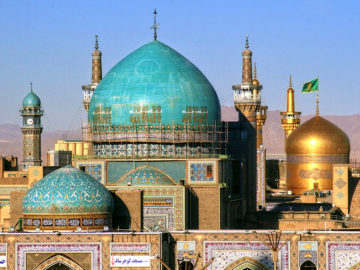
Ali Ibn Mussa Reza, known as Imam Reza is the eighth Shiite Imam who was martyred in 818 by Ma’mun, the caliph of the time, given that he feared the increasing power and popularity of the Imam. His body was buried in the mausoleum of Harun ol Rashid, the third Abbasid Caliph. This place then turned into a pilgrimage center and different rulers in the course of history tried to improve and glorify it, indicating the importance of Imam among Iranians.
The Samanid rulers (819-999) were the first to start a series of changes in the area, leading to the development of the city. However, in this period, the shrine did not extend. Daylamite, on the contrary, paid only attention to the shrine such that they repaired it completely. For example, they improved the decorations of the place drastically, added residential units to the garden of the shrine, and built a strong fortification around Mashhad City. Such measures ensured, to a great extent, the security of the place.

During the Ghaznavid Dynasty (977-1186), following the order of Mahmoud Ghaznavi, the main building of the shrine was repaired and several bazaars were built around it. In the Seljuk Dynasty (1037-1194), king Sultan Sanjar with his minister Sharaf al-Qomi ordered the construction of a dome over the shrine and also restoration of its damages. About a century later, Mohammad Kharazmshah ordered the decoration of the shrine with striking tiles that came to be known as Sanjar tile. At the present time, the remnant of these periods’ tiles is on display in the museum of the shrine.
In the 13th century, Mongols attacked various parts of Iran, leading to looting the town and murdering people. However, in the aftermath of the Mongols’ attacks, surprisingly, the shrine was left with minimal damages. During the Timurid Dynasty (1370-1507) as the descendants of Mongols, following Shahrukh Mirza’s efforts for the prosperity of Mashhad, and by the suggestion of his wife, Goharshad, a majestic mosque was built in the southern part of the shrine’s courtyard.
The mosque was named Goharshad since she played an important part in its construction. In the Safavid Period (1501-1736) as a state following the Twelver Shiite sect, much was added to the shrine. In this period, the tradition of gilding holy places started and thus, replacing the former brick and tile works of the Imam Reza Shrine’s dome with gold-coated bricks.
Shah Abbas also commanded to cover the rest of the shrine with gold and copper and to add more sections, an order that took more than 100 years to be implemented and so, the king could not see the outcome as he passed away sooner. The newly added sections in this period include courtyards, northern, western, and eastern Iwans, portals, chambers, and Allah Verdi Khan portico.

When Nader Shah of Afsharid Dynasty (1736- 1796) became the king of Iran and started a series of battles in the neighboring countries especially India, the country became richer. As a devoted follower of Islam, he ordered that two Iwans and the northern minaret to be gilded and the frescos of the place to be renovated. During the reign of Fath Ali Shah of the Qajar Dynasty (1789-1925), new sections were also added to the construct, including a courtyard named Freedom, the western Iwan was gilded, and a Ravagh (porch-like construct) named Dar ol Sa’ada literary meaning the House of Happiness.
At the time of Mohammad Reza Pahlavi (reign: 1941-1978), the governor of Khorasan Razavi Province developed the shrine. To this end, the gilded bricks were repaired, many of the old buildings were converted, and new constructs were added as well. The Riyadh mosque (the women’s mosque), back porch, Saqa Khaneh, and the former candelabrum were among the new sections. After the Islamic Revolution of 1978, the interior of the shrine’s main dome including its basis developed significantly so as to strengthen the dome’s stability.
Furthermore, the Courtyard of the Islamic Republic and the porches of Razavi, Guidance, Kosar, and Imam Khomeini were made, and more broadly, the shrine’s total area increased to 598,657 square meters, turning it to one of the biggest mosques of the world. At the present time, the Imam Reza complex consists of nine courtyards, 26 porches, two museums, four seminaries, a library, a cemetery, the Razavi University of Islamic Sciences, a dining hall, prayer halls, and so forth.

